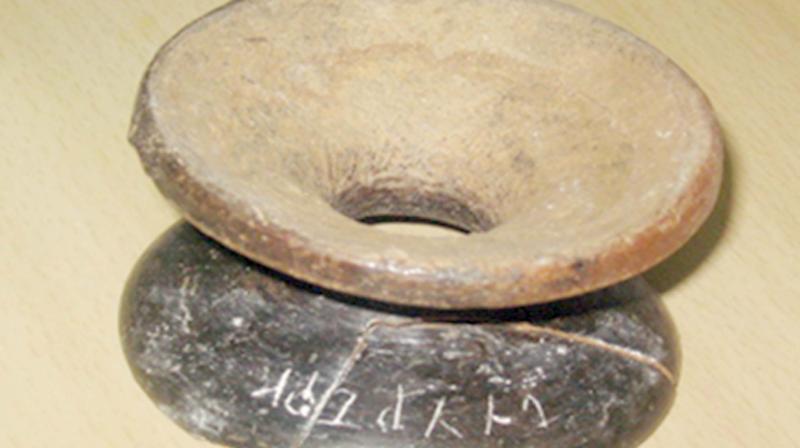Tamil Brahmi letters found in archaeological exploration

Coimbatore: A terracotta weight holder with inscriptions in Tamil Brahmi has been excavated by archaeologists at a megalithic site in 'Periathadagam,' on Coimbatore outskirts. The weight holder ('mann kalam thaangi') discovered at the site dates back to 2,500 years ago.
“These discoveries with inscriptions provide evidence to the rich literary knowledge of people, who had settled down in Thadagam area. The nature of inscriptions reveals that it belongs to Jain or Budhist traders,” said epigraphist S Ravi, who led the discovery along with Ravichandran and Balasubramanian, both former epigraphy students of PSG College of Arts and Science.
The Tamil Brahmi script on the 'thaangi' is read as 'thavan sathan' and is inscribed upside down. “It is in black and red colour. Though it is centuries old, the colour and texture still remain. The meaning of 'thavan sathan' could be a meditating hermit,” he said.
The latest discovery of articles with Tamil Brahmi inscriptions gains significance as archaeologists had found Tamil letters with striking similarity during excavations in places like Boluvampatty, Perur and Kodumanal areas along the Noyyal river basin.
According to the findings, Ravi said that people lived prosperously even 2,500 years ago in Thadagam, which means a water body. “It has been known from early settlers that people from Peelamedu came here with over 60 donkeys carrying loads of dirty clothes to wash,” Ravi said.
Renowned archaeologists Iravatham Mahadevan and Subbarayalu have confirmed that the inscription is Tamil Brahmi and could date back to 3rd century BCE.
Evidences also suggest that the ancient settlers were skilled in making terracotta handicrafts with an aesthetic sense and also had expertise in pottery.
“Significantly, pieces of a broken 'muthumakkal thali' (burial urns), huge stone slabs and bones of people buried at the burial site have also been excavated during the three-year long exploration. The collections were made from a vast land spread over in this place identified as 'Natham Oorkaadu',” he said.
In later years, the megalithic monuments at Periathadagam were destro-yed for building brick kilns by the settlers.

